Cliff swallows are amazing! There is much we can learn from them.
A cliff swallow’s survival depends on being part of a colony, and every swallow makes a contribution to their community. Swallow pairs take weeks constructing nests that will outlast their lifespans and will be used by future generations. They synchronize their nesting so the youngsters will leave the nests at the same time. The teenagers spend time together in large groups (creches) protected by all the swallow parents while hunting and flight training continues. This allows a second group of swallow parents to occupy the nests and begin nesting. Pretty amazing.
ABOUT THE SWALLOWS OF THE CAPISTRANO VALLEY
Here’s a link to a pdf to download – The Cliff Swallows of the Capistrano Valley – that contains this information.
Cliff swallows have nested in the Capistrano Valley for thousands of years. They are called cliff swallows because they build their nests on the faces of cliffs.
Swallows can still be seen throughout the Capistrano Valley, but are not as plentiful as the days when their flocks “darkened the skies.”
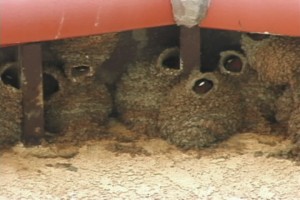
Cliff swallows build mud nests which last for generations, and many colonies have hundreds of nests. Some swallows still build nests on cliffs, but today, most swallows use protected buildings or bridges.
Because swallows eat flying insects, and insects are most plentiful in warm weather, the swallows must migrate to South America in the winter to follow the warm weather. Swallows spend most of their time in flight and even drink by scooping water while flying.
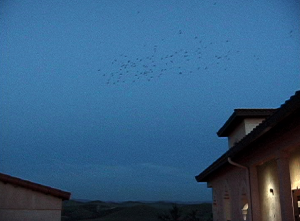
The first swallows arrive from South America in March. At sundown, they fly in “swarms” above their colony site to attract new residents. The colony grows in size from a few early birds to several hundred, or even thousands in larger colonies. During the display, the birds circle overhead, calling to each other. The swarm gets lower and lower, and finally the birds fly into the waiting nests for the night. In April, when the colony is just the right size, the swarming stops and nesting begins. 
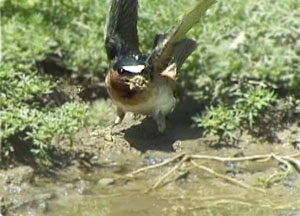
There are usually more pairs than available nests and pairs must compete for the best nests. When the first nests are claimed, the other pairs in the colony must build new nests. Nest building is hard work and depletes the resources that will be needed later to care for the new family. So, whenever possible, it is always better to use an existing nest than to build a new one.
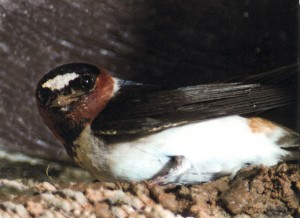
Nests are made of over 1,000 tiny mud pellets, each gathered by the beakful and carefully placed to form the nest. It takes between one and two weeks to build a nest. Both parents share building duty and take turns bringing mud. While one visits the mud site, the other guards the nest. Swallows are known to steal mud from each other during nest building, so both parents have important jobs.
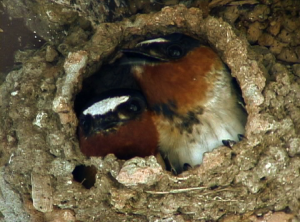
When the building is complete, parents line the nest with grasses and feathers, and soon three or four eggs are laid. Both parents incubate the eggs, and the eggs hatch in about 2 1/2 weeks.
The survival of the colony depends on synchronized activity and working as part of a group. Groups communicate information about the location of insects, mud, water, and predators. Nesting is also synchronized so that large numbers of swallow chicks hatch on the same day. 
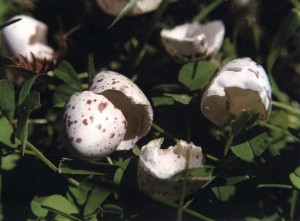
The first chicks in the colony hatch in May. Evidence of the new arrivals is everywhere, as neatly broken eggshells cover the ground under the nests.
Both parents care for their babies, and during the day, they bring insects back to the nest every few minutes. The babies grow rapidly and are ready to leave the nest at three to four weeks old.
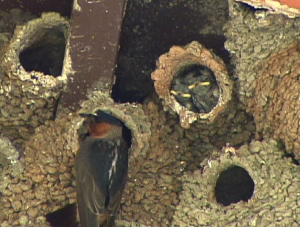
Swallow parents are very clever when teaching their chicks to fly. They bring an insect to the hungry baby, but instead of feeding him, they fly away with the insect. They return again, and again fly away without feeding their youngster. Finally, the hungry chick leaps from the nest to follow the parent, and is suddenly flying. Parents give flying lessons for several days before the chicks finally leave the nest and join the colony.
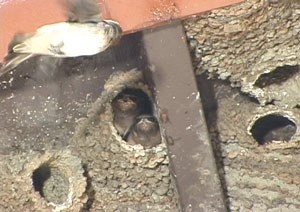
In June, when the chicks have left the nest, new swallow pairs use the empty nests to raise their families.
After the young swallows leave the safety of the nest, they still have much to learn about catching their own insects and avoiding predators. Swallow parents lead their youngsters to a “creche” – a large group of other young swallows ą and continue their training. 
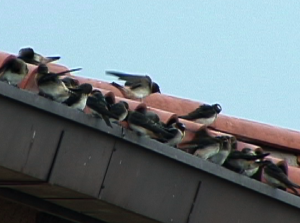
Adults in the colony supervise and protect the young ones while parents continue feeding and training them.
Because creches can contain hundreds of young swallows, parents must be able to quickly recognize their own youngsters.
Fortunately, all young swallows have distinct feather patterns on their faces, and no two are alike. They also have unique voices, so their parents are able to recognize their offspring by sight and by sound in a very large, noisy crowd.
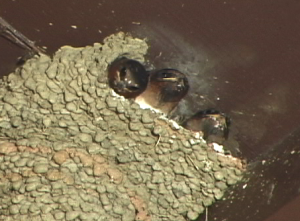
Parents are very skilled at teaching their youngsters to hunt insects in flight. First, they feed the young swallow in flight by transferring an insect from beak to beak. Then the parent drops insects for the youngsters to catch. Finally, the young swallows are able to pursue and catch their own insects.
The last young swallows leave the nests in August, and the colony remains in the Capistrano Valley until September or October. They gather strength and prepare for their migration to South America which begins with the cool fall weather.
Little is known about their lives during their winter in South America. The colony probably remains together, moving from place to place to follow the swarms of insects.
Swallows are most vulnerable during their first year when they must become successful insect hunters, learn to avoid predators, and survive the migration to South America and back again.
The life span of the cliff swallow is probably four to five years, although there are documented reports of eleven year old swallows.
FOR EVEN MORE INFORMATION The world cliff swallow expert is Dr. Charles Brown, University of Tulsa.
Here are just two of his publications:
Brown, C. R. and M. B. Brown, 1996. Coloniality in the Cliff Swallow: the Effect of Group Size on Social Behavior. Univ. Chicago Press, Chicago.
Brown, C. R. 1998. Swallow Summer. Univ. Nebraska Press, Lincoln.
Enjoy the Swallows!
